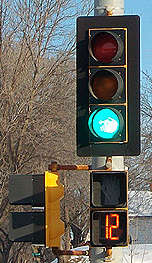 The advent of the LED signal brings quite a few benefits, but it also brings some problems.
The advent of the LED signal brings quite a few benefits, but it also brings some problems. The advent of the LED signal brings quite a few benefits, but it also brings some problems.
The advent of the LED signal brings quite a few benefits, but it also brings some problems.
Here are the pros and cons of LED signals:
The LED signal, by emitting energy in only one narrow band, and not emitting much heat, needs much less energy to work.
The lifetime is much longer than that of an incandescent bulb. While a standard incandescent bulb lasts about 1000 hours, an LED can last as long as 30000 hours.
The colors are pure hues, tailored to the specified colors for traffic signals. Colored lenses used with incandescent lamps can not provide such purity (especially for green signals), and can fade over time.
LED signals draw much lower currents, meaning that the signal wires do not need to be as large.
Because the signal lamps draw much lower currents, traffic signals can operate at low enough currents to be given a battery backup. This keeps the signal operating during power failures.
CONS:
|



















|
Protect the lamp assembly with internal multiple low-pass filters. Use more robust electronics.
If the low-pass filters mentioned above have long enough time constants, they will also make the LEDs dim and brighten as incandescent lights do. So the same device cures three problems.
 Snow Collects in LED Signal Visors
Snow Collects in LED Signal Visors
There are three known solutions:
Nothing except a relamping schedule can guard against this.
Replacing the conflict monitor with a new one cures this.